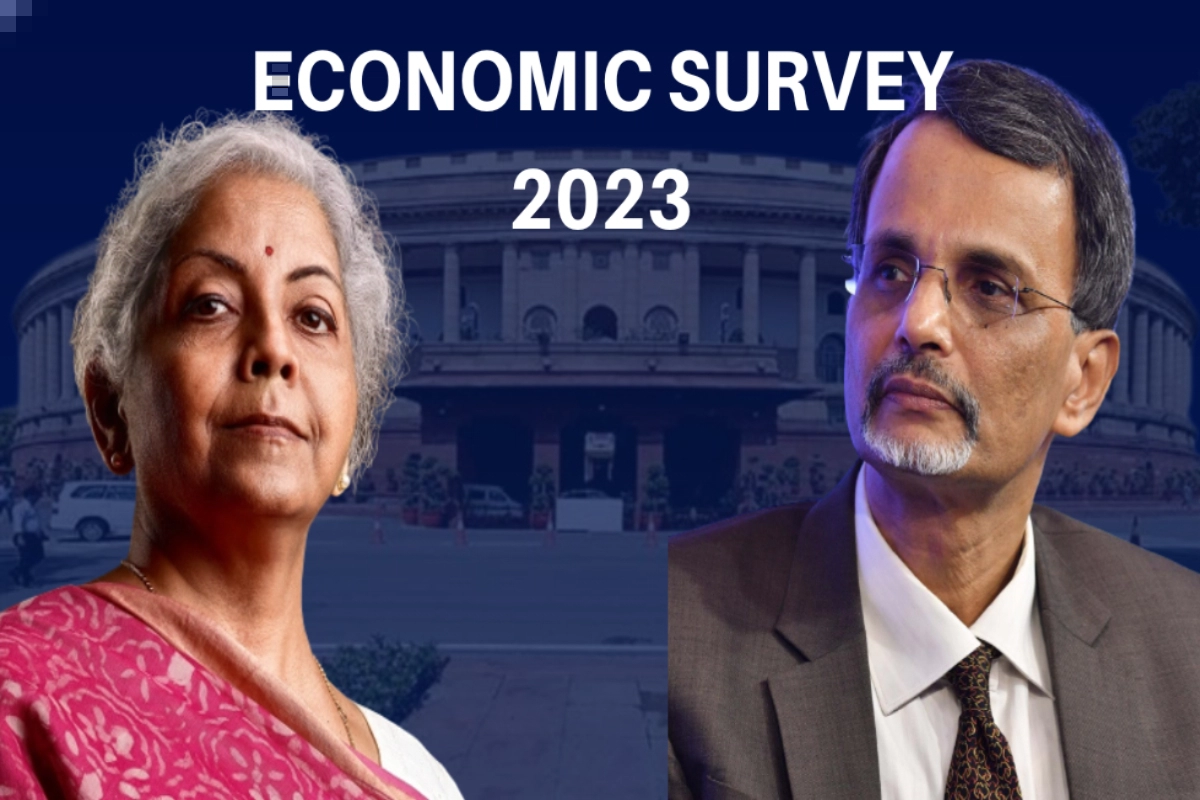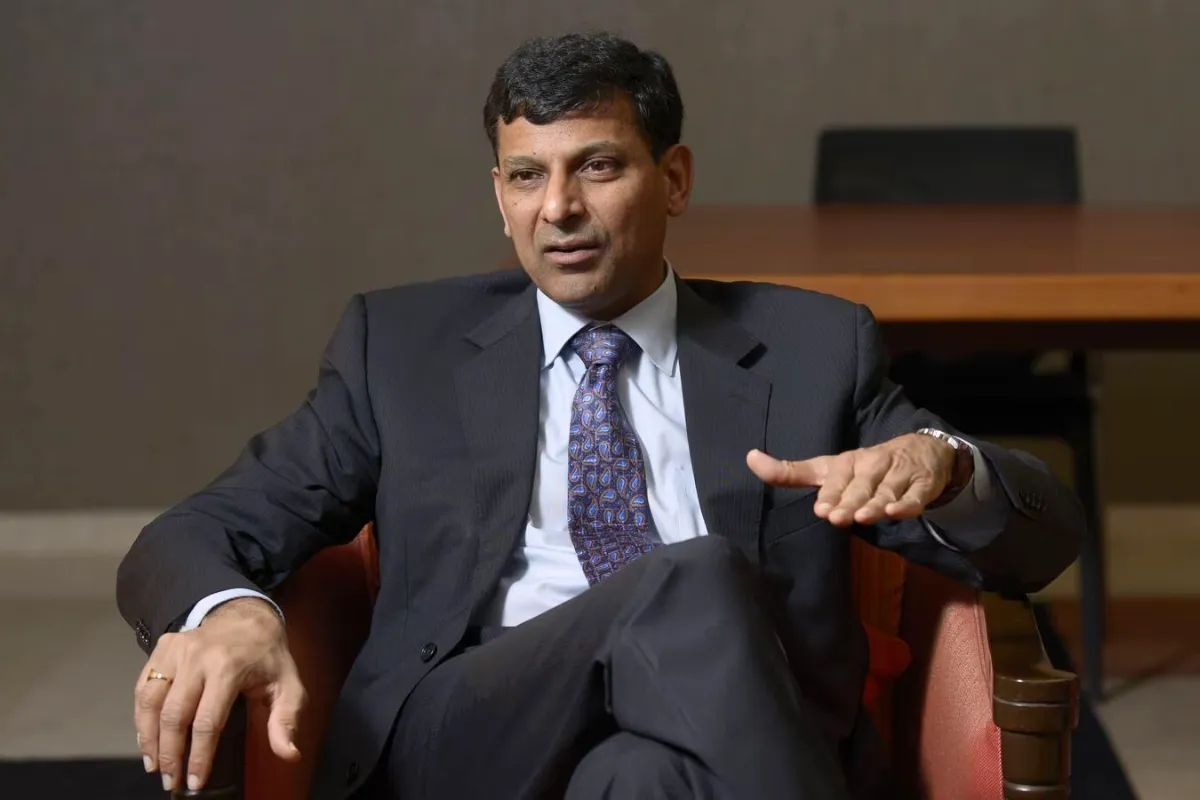Union Finance Minister Nirmala Sitharaman tabled Economic Survey in the Parliament with projections for economic growth for fiscal 2023-24.
According to the Economic Survey, which was prepared by the Department of Economic Affairs (DEA) under the guidance of Chief Economic Advisor V Anantha Nageswaran, India’s GDP growth is anticipated to remain strong, and the nation will continue to have the fastest growing major economy in the world due to its success in overcoming the extraordinary range of challenges the world has had to face.
The Survey did point out that because of ingrained inflation, the tightening cycle may last longer and borrowing costs may continue to be “higher” for a longer time.
Key Highlights of Economic Survey 2023
GDP Growth: India’s Covid recovery complete
* India will continue to be the world’s fastest-growing major economy. The Indian economy is undergoing a broad-based recovery across sectors as it recovers from the pandemic-induced contraction, the Russian-Ukrainian conflict, and inflation. It is positioned to resume its pre-pandemic growth path in FY23.
* It is anticipated that India’s GDP would expand by 7% (in real terms) in FY23. This comes after a growth of 8.7% in the previous fiscal year.
Depending on the direction of global economic and political developments, GDP is expected to be in the range of 6–6.8% for FY24.
* According to the Economic Survey 2022–23, the nominal and real GDP growth rates for FY 24 are projected to be 11% and 6.5%, respectively.
* India recovered from the pandemic quite quickly, and growth will be aided in the following year by strong domestic demand and an increase in capital expenditure. A new cycle of private capital creation is beginning to emerge, helped by strong financial conditions. More importantly, the government has increased capital spending significantly in order to make up for the private sector’s conservatism.
India’s economy ranks third in terms of purchasing power parity and fifth in terms of exchange rate.
* Private consumption as a percentage of GDP reached 58.5% in Q2 of FY23, the highest second quarter since FY15, thanks to a recovery in contact-intensive sectors including commerce, lodging, and transportation.
Private consumption, more capital expenditures, a stronger corporate balance sheet, increased financing to small enterprises, and the return of migrant workers to cities all contributed to growth.
* The economy has almost “recouped” what it lost, “renewed” what had stopped, and “renergised” what had stalled due to the pandemic and the European conflict.
* One of the growth drivers of the Indian economy this year is the Central Government’s Capital Expenditure and the crowding in of private Capex driven by the strengthening of Corporate Balance Sheets.
Also Read: Union budget 2023: Why middle class should be looking forward to February 1
Increasing borrowing costs due to inflation
Although India’s retail inflation rate peaked in April 2022 at 7.8%, exceeding the RBI’s top tolerance limit of 6%, India had one of the lowest overshoots of inflation above the target range in the world.
* According to the RBI, this fiscal’s inflation is expected to average 6.8 percent, which is more than the upper goal limit but not high enough to discourage private spending or investment incentives.
* The cost of borrowing could be “higher for longer,” and the tightening cycle could be prolonged by ingrained inflation. * India’s successful handling of inflation stands out in comparison to advanced economies that are currently battling high inflation rates
Credit Growth Remarkably High
*From January to November 2022, credit growth to the Micro, Small and Medium Enterprises (MSME) sector averaged above 30.5 percent.
*Another growth engine for the Indian economy this year was the Central government’s capital spending, which rose by 63.4% in the first eight months of FY 23.
Widening of the current account deficit
The Economic Survey warns that despite outperforming most other currencies, the rupee’s depreciation problem persists due to the possibility of more US Fed policy rate hikes.
* As long as economic growth momentum is strong and global commodity prices are elevated, the CAD may continue to widen.
* If the current account deficit increases, the rupee may experience pressure.
* The CAD is exposed to a variety of risks. Despite falling from record highs, commodities prices are still higher than they were prior to the conflict. It has increased the current account deficit (CAD), which was already growing as a result of India’s rising pace.
*India has enough foreign exchange reserves for FY 23 to cover the CAD and to act in the foreign exchange market to control currency volatility.
Surging Exports
* The export growth that surged in FY22 and the first half of FY23 caused the production processes to transition from modest acceleration to cruising mode.
*From US $4.4 billion in FY19 to US $11.6 billion in FY22, electronics exports nearly tripled.
Fiscal Position: Revenue Generation performing resolutely
* The government’s finances have performed well during FY23, helped by a resurgence in economic activity and a pickup in direct tax and GST receipts..
* From April to November 2022, the Gross Tax Revenue increased by 15.5% YoY, mostly due to strong growth in the direct taxes and GST.
* Direct tax growth was significantly greater in the first eight months of the year than the matching longer-term averages.
* With the gross GST collections increasing at a YoY rate of 24.8% from April to December 2022, the GST has stabilised as an important source of revenue for the Central government and state governments.
* From a long-term average of 1.7% of GDP (FY09 to FY20) to 2.5% of GDP in FY22 PA, the Center’s Capex has consistently climbed.
*The rise in Capex has significant favourable effects on medium-term growth, with a focus on infrastructure-intensive industries including roads and highways, railroads, and housing and urban affairs.
*India will be able to maintain a positive growth-interest rate differential thanks to the government’s capex-led growth plan, which will result in a medium-term debt to GDP ratio that is manageable.
Monetary Policy: A Good Year
* The RBI started its cycle of monetary tightening in April 2022 and has since raised the repo rate by 225 bps, which has caused the conditions of excess liquidity to moderate.
* Financial institutions increased their lending as a result of cleaner balance sheets.
* The increase in loan offtake is anticipated to continue, and when coupled with a rise in private capital expenditures, will start a positive investment cycle.
Since April 2022, scheduled commercial banks’ (SCBs’) offtake of non-food loans has increased by double digits.
* Non-Banking Financial Companies’ (NBFCs) issuance of credit has also increased.
* The ratio of gross non-performing assets (GNPA) has decreased to 5, the lowest level in seven years.
* At 16.0, the Capital-to-Risk Weighted Assets Ratio (CRAR) is still in good shape.
Social Infrastructure and Employment
* Government spending increased significantly in the social sector.
* Budgeted spending on the health sector by the federal government and state governments reached 2.1% of GDP in FY23 (BE) and 2.2% in FY22 (RE), respectively, up from 1.6% in FY21.
* Social sector spending rose from Rs. 9.1 lakh crore in FY16 to Rs. 21.3 lakh crore in FY23 (BE).
The Aspirational Districts Programme has become a model for effective government, particularly in isolated and challenging places.
. * By enabling the people, the JAM (Jan-Dhan, Aadhaar, and Mobile) trinity has revolutionised the route to transparent and accountable governance by bringing the underserved segments of society into the official financial system.
* The Co-WIN platform’s development and the transparent distribution of more over 2 billion vaccine doses were both made possible because to Aadhaar.
Unemployment Rate Falling
* Both in urban and rural areas, the labour markets have improved beyond pre-Covid levels, with unemployment rates falling from 5.8% in 2018–19 to 4.2% in 2020–21.
Education
*Gross Enrolment Ratios (GER) in schools and gender parity both improved in the fiscal year FY22. GER in the primary enrollment in classes I to V as a percentage of the population in the age range of 6 to 10 years has improved in FY22 for both boys and girls.
Health
* As a result of numerous health-related government initiatives, out-of-pocket spending as a share of overall health spending decreased from 64.2% in FY14 to 48.2% in FY19.
* There has been a consistent drop in the infant mortality rate (IMR), under-five mortality rate (U5MR), and neonatal mortality rate (NMR).
* As of January 6, 2023, more than 220 crore COVID vaccination doses had been given.
*As of January 4th, 2023, around 22 crore beneficiaries of the Ayushman Bharat Scheme had been confirmed. Under Ayushman Bharat, more than 1.54 lakh Health and Wellness Centers have been operationalized nationwide.
Agriculture and allied sector performance have been buoyant
* In 2020–21, private investment in agriculture will rise to 9.3%;
* since 2018, the MSP for all mandatory crops has been fixed at 1.5 times the weighted average cost of production for all of India.
Institutional Credit to the Agricultural Sector grew to 18.6 lakh crore in 2021–2022 as growth persisted.
* Free foodgrains to about 81.4 crore people under the National Food Security Act for one year beginning January 1, 2023. India’s foodgrain output increased steadily and reached 315.7 million tonnes in 2021–22.
* In its April–July 2022–23 payment cycle, the Scheme covered around 11.3 crore farmers.
* Under the Agriculture Infrastructure Fund, Rs 13,681 crores were sanctioned for post-harvest support and community farms.
* The National Agriculture Market (e-NAM) Scheme established an online, competitive, transparent bidding system involving 1.74 crore farmers and 2.39 lakh traders.
* Organic farming is being encouraged through Farmer Producer Organizations (FPO) under the Paramparagat Krishi Vikas Yojana (PKVY).
* India is at the vanguard of the International Year of Millets effort, which seeks to promote millets.
Industry: Steady Recovery
* For the first half of FY 22–23, the industrial sector’s overall Gross Value Added (GVA) increased by 3.7%, exceeding the 2.8% average growth seen in the same period last decade.
A demand stimulus for industrial growth has been created by the robust growth in private final consumption expenditure, the export stimulus year, an increase in investment demand, and strengthened bank and company balance sheets.
The industry’s supply response to the demand stimulus has been strong.
Since July 2021, the PMI manufacturing index has been in the expansion zone, and the Index of Industrial Production (IIP) is expanding at a solid rate.
* Since January 2022, lending to Micro, Small and Medium-Sized Enterprises (MSMEs) has increased by an average of about 30%, and credit to big industries has increased by double digits since October 2022.
* With a rise in handset manufacturing from 6 crore units in FY15 to 29 crore units in FY21, India has overtaken China as the second-largest mobile phone manufacturer in the world. From US $180 million in FY19 to US $699 million in FY22, FDI flows into the pharmaceutical industry have increased by a factor of four.
* The Production Linked Incentive (PLI) programmes, with an expected expenditure of 4 lakh crore over the next five years, were established across 14 categories, tying India into international supply chains. In the FY22, investments under PLI schemes totaled Rs. 47,500 crore, or 106% of the year’s authorised objective. Due to PLI initiatives, 3.85 lakh crore in production/sales and 3.0 lakh new jobs have been reported. As of January 2023, more than 3500 requirements have been decriminalised, and over 39,000 compliances have been decreased.
Services: Source of Nation’s Strength
* In comparison to FY22’s 8.4% (YoY) growth, the services sector is predicted to expand by 9.1% in FY23.
* Since July 2022, there has been a significant expansion in PMI services, a sign of activity in the services industry.
* India, whose share of global commercial services exports increased from 3% in 2015 to 4% in 2021, was one of the top ten nations exporting services in that year. Since July 2022, credit to the services sector has increased by more than 16%.
* Inflows of FDI equity in the services sector totaled US$7.1 billion in FY22.
In FY23, contact-intensive services are expected to resume growth rates similar to those before the epidemic. Housing sales are reaching pre-epidemic levels as a result of real estate industry growth, which is expected to increase by 50% between 2021 and 2022.
* The percentage of hotels that are occupied increased from 30–32% in April 2021 to 68–70% in November 2022. With the return of regularly scheduled international flights and the relaxation of Covid-19 requirements, the tourism sector is exhibiting signs of recovery, with foreign visitor arrivals in India in FY23 increasing month over month. Through 2025, the e-commerce market in India is anticipated to develop at an average rate of 18%.
External Sector
*From April to December 2022, India’s merchandise exports totaled $332.8 billion. India expanded its exports to Brazil, South Africa, and Saudi Arabia.
*In 2022, CEPA with the UAE and ECTA with Australia go into effect in an effort to expand its market and guarantee better penetration. India will receive US$ 100 billion in remittances in 2022, making it the largest recipient in the world. After service export, remittances are the second-largest main source of external financing.
* The Forex Reserves were $563 billion as of December 2022, representing 9.3 months’ worth of imports.
* India has the sixth-largest amount of foreign exchange reserves as of the end of November 2022. The existing amount of foreign exchange reserves provides enough protection against the current stock of external debt. In terms of both overall debt and short-term debt as a percentage of total debt, India has very low levels.
National Infrastructure Pipeline
* 89,151 projects with a total cost of 141.4 crore rupees are in various stages of implementation; 1009 projects costing 5.5 billion rupees have been finished.
National Monetization Pipeline
* 89,151 projects worth $141.4 crore in various phases of implementation; 1009 projects worth 5.5 billion dollars have been completed.
* FY23 target is envisaged to be ₹1.6 lakh crore (27 per cent of overall NMP Target)
GatiShakti
* Renewable Energy and the Electricity Sector
* As of September 30, 2022, the government has authorised the construction of 59 Solar Parks throughout 16 states, totaling the 40 GW target capacity.
* 17.2 lakh GWh of electricity were produced in FY22 versus 15.9 lakh GWh in FY21. By industries with demand of 1 Mega Watt (MW) or more, the total installed electricity capacity climbed from 460.7 GW on March 31, 2021, to 482.2 GW on March 31, 2022.
Making Indian Logistics Competitive Globally
* There has been a considerable rise in the length of national highways (NHs) and roads being built, with 10457 km in FY22 compared to 6061 km in FY16.
* Capital expenditures received a significant boost from budget expenditures, which rose from Rs. 1.4 lakh crore in FY20 to Rs. 2.4 lakh crore in FY23. Since the UDAN programme began in 2016, more than one crore air travellers have benefited from it.
* An almost twofold increase in major ports’ capacity in 8 years.
India’s Digital Growth
*Between 2019 and 22, the value and volume of UPI-based transactions increased by 121% and 115%, respectively, paving the door for its global adoption. As of September 22, there were 117.8 crore telephone users in India, with 44.3% of those located in rural areas. More than 98% of all telephone subscribers are wirelessly connected. In India, the overall tele-density was 84.8% as of March 22. Between 2015 and 2021, the number of rural internet subscribers will climb by 200%.
Also Read: India must be resolute and stop buying Chinese made products, says Delhi CM Arvind Kejriwal
Keep watching our YouTube Channel ‘DNP INDIA’. Also, please subscribe and follow us on FACEBOOK, INSTAGRAM, and TWITTER












